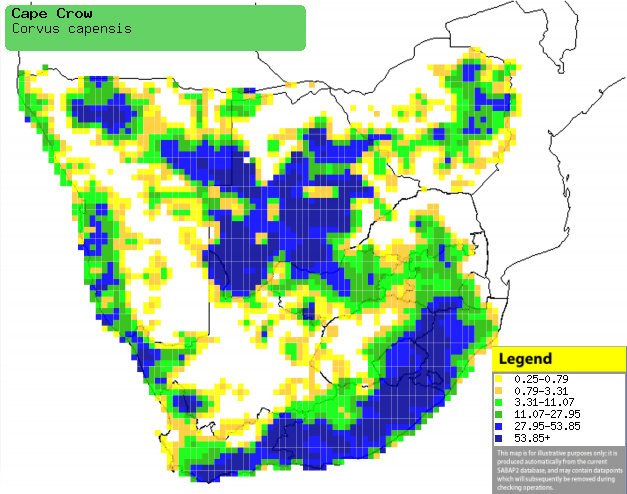|
Corvus capensis (Cape crow, Black crow)
Swartkraai [Afrikaans]; Unomyayi [Xhosa];
iNgwababane [Zulu]; Ekorova (generic term for crows) [Kwangali];
Lekhoaba, Mokhoabane [South Sotho]; Segogobane [North Sotho];
Chikungubaya [Shona]; Gunguva, Qugwana, Xikhunguba [Tsonga];
Lehukubu [Tswana]; Kaapse roek [Dutch]; Corneille du Cap [French];
Kapkrähe [German]; Gralha do Cabo [Portuguese]
Life
> Eukaryotes
>
Opisthokonta
> Metazoa
(animals) > Bilateria > Deuterostomia >
Chordata > Craniata > Vertebrata (vertebrates) > Gnathostomata (jawed
vertebrates) > Teleostomi (teleost fish) > Osteichthyes (bony fish) > Class:
Sarcopterygii (lobe-finned fish) > Stegocephalia (terrestrial vertebrates) >
Tetrapoda (four-legged vertebrates) > Reptiliomorpha > Amniota >
Reptilia
(reptiles) > Romeriida > Diapsida > Archosauromorpha > Archosauria >
Dinosauria (dinosaurs) > Saurischia > Theropoda (bipedal predatory
dinosaurs) > Coelurosauria > Maniraptora > Aves (birds) >
Order: Passeriformes > Family:
Corvidae
Distribution and habitat
It has two separate populations - one in East Africa and
the other from Angola to southern Africa. Here it is common in Zimbabwe,
Botswana, Namibia and South Africa, largely absent from the Kalahari and
Mozambique. It generally favours open habitats with scattered trees, such as
open savanna woodland and grassland, but it is also common in semi arid
shrubland, alien plantations and farmlands.
|
 |
|
Distribution of Cape crow in southern Africa,
based on statistical smoothing of the records from first SA Bird Atlas
Project (©
Animal Demography unit, University of
Cape Town; smoothing by Birgit Erni and Francesca Little). Colours range
from dark blue (most common) through to yellow (least common).
See here for the latest distribution
from the SABAP2. |
Brood parasites
It has been recorded as host of the
Great spotted cuckoo.
Food
Omnivorous, feeding on a wide range of animals and plants.
It mainly forages on the ground, searching the bases of plants and responding to
any temporary abundance of food, such as termite alate emergences. The following
food items have been recorded in its diet:
- Animals
- arachnids
- insects
- freshwater snails (Ampupullaria)
-
termite alates
- once recorded with a Lycodonomorphus rufulus (Brown water snake)
in its bill
- Plants
- fruit and seeds
- Atriplex semibaccata (Creeping saltbush)
- Diospyros (jackal-berries)
- Scutia myrtina (Cat-thorn)
- Euclea undulata (Small-leaved guarri)
- Lycium (Honey-thorn)
- Thesium lineatum (Witstorm)
- maize
Breeding
- The female does most of the nest construction, while the male collect the
materials. It consists of a large cup of sticks and twigs, thickly lined
with soft material such as feathers, fur, sheep's wool, dry dung, string and
cloth. It is usually placed in the sleder branches of a tall shrub
,especially Rhigozum obovatum (Granaatbos) in the Karoo, but also in
Acacia and Eucalyptus trees, utility poles and rarely cliff
edges.
- It lays 1-6, usually 3 eggs, which are incubate by both sexes for about
18-19 days.
- The chicks are cared for by both parents, leaving the nest at about
26-39 days old and becoming independent roughly 6 months later.
Threats
Not threatened, in fact quite common in protected areas.
References
-
Hockey PAR, Dean WRJ and Ryan PG 2005. Roberts - Birds of
southern Africa, VIIth ed. The Trustees of the John Voelcker Bird Book
Fund, Cape Town.
|
